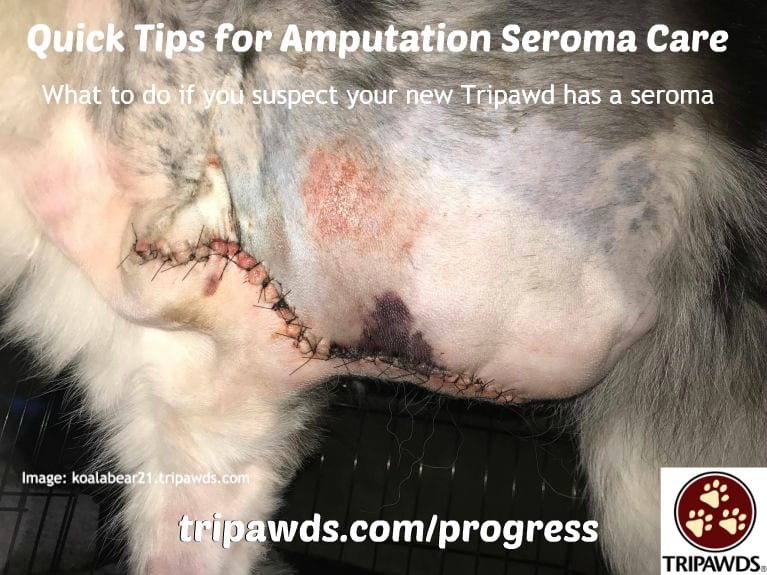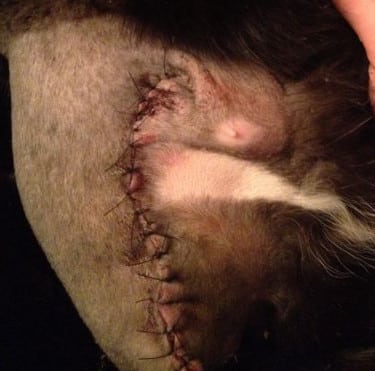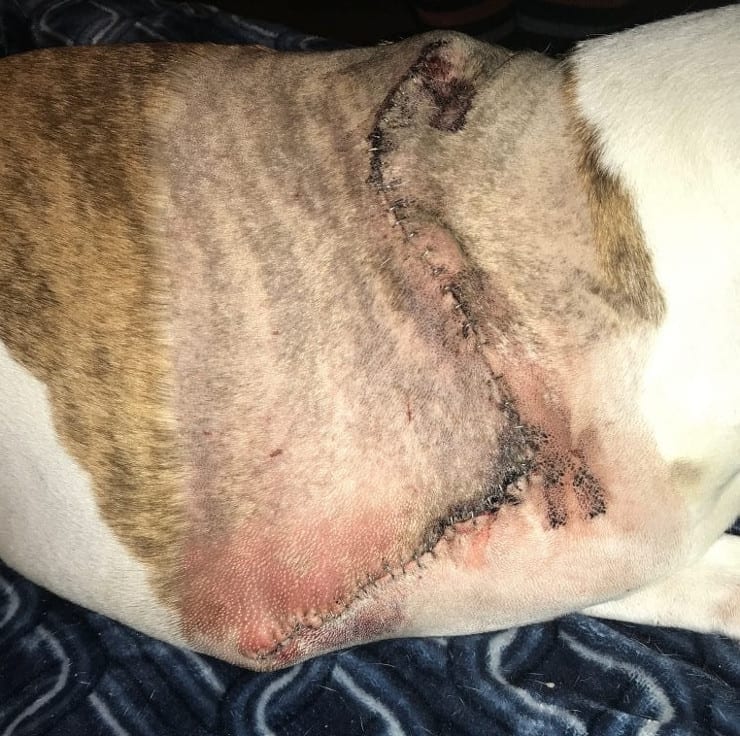If your brand new amputee dog or cat has a puffy area at the incision site, odds are pretty good it’s a “seroma” sweling. This fluid build-up usually isn’t serious but it does require some extra attention. These tips for Tripawd amputation seroma swelling care should help.
Quick Tips for Tripawd Amputation Seroma Swelling Care

We all know that our bodies are filled with fluids. So when part of a body is taken away, that fluid has to go somewhere, right? For new amputee pets, that fluid should reabsorb into the body, but sometimes takes the path of least resistance and pools up at the incision site.
What does a Seroma look like?
A Tripawd amputation seroma looks puffy, like a water balloon all around the incision area. Actually, this can happen in any kind of surgery, even a simple spay/neuter procedure.
You may notice a clear, watery, pinkish fluid leaking out too. In this short video, Dr. Krista Magnifico demonstrates. Her article about dog seromas, “Seroma, the Pocket of Fluid to Keep Quiet,” is helpful.
What a Seroma does not look like:
- The fluid is not thick, purple or bloody in color.
- Nor is the fluid warm to the touch.
Either way, your vet needs to know about the suspected seroma. The fluid will usually reabsorb into the body without intervention. But if it’s an amputation infection and is not treated quickly, bacteria can get in and destroy tissues around the sutures. They might even come undone and require a “debridement” surgery to remove the dead tissue. Don’t let this happen to your new Tripawd. Follow these tips.
How to Manage Amputation Seroma Swelling in Tripawd Cats and Dogs

Call your vet to let them know you suspect a seroma. But before doing so, watch how quickly the fluid is dripping and make a note of it for your vet. If the fluid drips faster than one drop per second, the vet will probably ask you to come in. Meanwhile, you can do a few things help your pet’s body absorb the fluid.
Apply a warm compress on the seroma area.
Here’s how to do it, according to Tripawds member paws120, a former veterinary technician and mom to Trikitty Huckleberry:
- Just get a nice old soft face cloth or hand towel and run some warm water on it.
- I start out with hot, wring it out then shake it till it gets to a nice warm temp but not too hot.
- Gently place the face cloth on the incision and hold it there for a few minutes. That’s really all there is to it.
- I wring it out pretty well too.. so that it isn’t dripping. You can do this several times a day.
Try a cabbage poultice.
Believe it or not, a cabbage can speed wound healing and ease joint pain. Click on the link to follow application instructions by Tripawds member Dottie. This cabbage poultice application video shows how to make one too.
Keep you pet quiet and avoid too much activity.
Seromas can be caused by moving around too much before the body is in full healing mode. Keep your Tripawd mellow during recovery time.
Use the Cone of Shame or Tripawd Recovery Suit.
We can’t say it enough: a cone of shame or Tripawd Recovery Suit is the best way to guarantee your pet won’t bother the incision and create a worse situation at the seroma swelling site. Dogs and cats can destroy incision sutures even when you think you are watching. Don’t risk it!

An amputation seroma looks scary but it’s usually harmless. If you think your Tripawd has a seroma, don’t panic. Let your vet know what’s going on as soon as you can and come to the Tripawds Treatment and Recovery Discussion Forum topic for support from the community.
Recommended Reading About Tripawd Seroma Swelling Care
Amputation Wound Care for Post-Surgery Dogs and Cats
Post-Amputation Side Effects in Dogs and Cats
Dog Leg Amputation Seromas: What You Need to Know
My dog had a right rear amputation on Monday. He came home today (Wednesday). He is preferring to lay on the amputation side. Should I encourage him to lay on the other side? Will blood pooling cause a seroma to form?
Amy, please post in our Forums so we can help you and your dog along this journey OK? It’s perfectly fine to lay on the amputation side as long as he seems comfortable. A seroma is caused by too much activity and general fluid build up but as far as I know I’ve never heard of one being caused by laying on the amp side. It’s a great question for your vet though. Hope to see you in the Forums!
Hi Jerry. Our golden just had a front leg amputation a week ago and developed a seroma that they drained today and put in a tube. My question is would this seroma cause her to have stomach or intestinal pains. She has had these pains after going to the bathroom and they put her in distress for about 20 minutes.
Alan, this is a great question for your vet team. Let them know about her symptoms. It sounds like she has untreated pain happening. And come to our Forums so we can help you better OK?
Can I use a “hot therapy” gel pack or do you need the moist heat ?
Jane, I would be super careful with hot therapy pads, they can get too hot. I’d stick with a warm washcloth to be safe.
All I was told about was to apply a COLD COMPRESS to swollen areas. I was told that “he has pockets of fluid, nothing to worry about.”
THEN blood flowed three or four days post op.
I was told a tight wrap, antibiotics, and to unwrap and wash a drain daily. My dog’s remaining right leg is swollen. “apply a cold compress, ” texts the vet.
I am filled with hatred currently.
4-14-2023
Gina, if it is truly bloody and not a seroma which is pink-tinged fluid, but not 100% blood, it’s time to take your dog to the ER. Please do not hate your vet. They are doing the best they can and I’m sure are willing to talk on the phone for more concise instructions. Join our Forums so we can help you better OK?
My baby has bruise and a small pocket fluid my baby just got her whole shoulder n leg amputated Thursday and I don’t know what to do about the smell pocket fluid n bruise any suggestions first time mama of tripod.
Diana, let your vet know this is happening. It’s nothing to panic about and usually a warm washcloth compress applied a few times a day can help the fluid drain out. But let your vet know just in case. And then join us in the Forums so we can continue to help you and your Tripawd!
Wonderful article – the seroma drainage was by far the most stressful and terrifying part of recovery for us! Thanks to you guys, we realized it was completely normal and found the best ways to care for our girl and keep her comfy 🙂
Yay! I’m so glad you found this helpful for Ziva’s recovery. Thanks for the feedback, give her a smooch from us.
How many times did you apply the compresses in day. Also, how many times did you get them up to go potty?
Jeri, please join us in our Discussion Forums so we can help you better OK? It’s best to get compress instruction from your vet, but generally a few minutes at a time (say 5), 3x daily may be helpful. As for pottying, just try to stick to the schedule your dog had before but don’t expect too much. Not sure where you are in recovery but most dogs don’t poop for a few days so don’t panic if that’s the case. Again, join our forums so we can help.